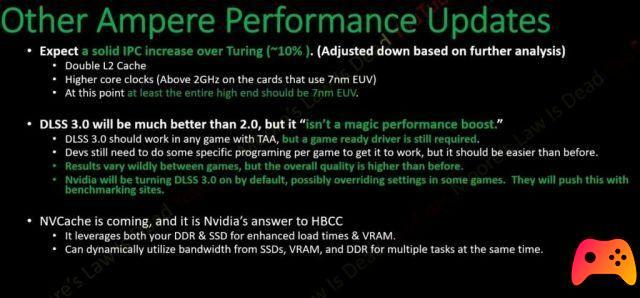
It has been many months since the genesis of the nvidia graphics card RTX 3080 Ti is holding the bench among the fans, however up to now very little information had leaked, obviously unofficial and always in the field of "ifs" and "buts". Instead, the news of these days is the existence of a sort of coming directly from sources inside Nvidia that would shed some light on the product that everyone is waiting for. So let's take a look at it.

The report talks about major changes in the card design Founders Edition (reference) from NVIDIA, as well as what's on the microchip. For starters, the RTX 3080 Ti reference design board presents a cooling solution a triple fan, unlike the RTX 20 series which used a dual fan. Reportedly, this cooler is quieter of the RTX 2080 Ti FE cooling solution. The card will be powered by a pair of PCIe power connectors a 8 pin. Display outputs include three DPs and one each of HDMI e VirtualLink USB-C. Rumors also confirm that “Ampere” will implement the host interface PCI-Express gen 4.0 x16.

With “Ampere“, NVIDIA is developing three levels of high-end GPUs, with "GA102"At the head of the group to replace the" TU102 ","GA104”Which holds the higher performance segment replacing today's“ TU104 ”and, a new microchip code name "GA103“, Completely new and therefore not derived from any predecessor of the current generation. Reportedly, “GA102” features 5.376 CUDA “Ampere” cores (IPC up to 10% higher than "Turing"). This microchip also draws on the much-acclaimed silicon-class manufacturing node 7 nm to achieve GPU clock speeds well above 2,20 GHz also for "GA102". Also according to rumors, the smaller chips in the series may have a clock rate above 2,50 GHz. Even with a slightly reduced "GA102" for RTX 3080 Ti, the chip could achieve processing performance FP32 higher than 21 TFLOP. The card will use memory GDDR6 a 18 Gbps faster, reaching 863 GB / s of memory bandwidth which is the 40% higher to that of the RTX 2080 Ti (if the width of the memory bus reaches 384 bits).

As for the performance, the prototype based on "GA102" would be recording 40% higher performance than RTX 2080 Ti with UHD 4K resolution in poorly optimized games, higher performance of the 50% on optimized games and performance up to 70% at best, in a scenario that provides a game optimized for the “Ampere” architecture. We know from old rumors that, by increasing the number of streaming multiprocessors, NVIDIA double the CUDA core, all to the advantage of greater ray tracing performance.
Each RT “Ampere” core is capable of processing 70 times the radiating power, more intersections per unit of speed than in “Turing”. The number of tensor cores will also reportedly see an increase. Attention to the ray-tracing and increased AI performance could give game developers the freedom to cram more RTX effects per title, allowing users to disable whatever they want on older “Turing” cards. The performance limitations on “Turing” have in fact caused developers to choose from the RTX feature set what to implement and what not. With “Ampere”, NVIDIA could introduce DLSS 3.0, updated image quality and improved performance. The company could also brush up on a technology of hybrid memory similar to HBCC by AMD, called NVCache, which spreads video memory through video memory, system memory, and flash-based storage.
Finally, there is more clarity about the silicon manufacturing process that NVIDIA could use. Apparently, NVIDIA will distribute its product stack between two types of 7nm class nodes. The ASIC high-end, such as “GA102” and “GA103”, could be built on nodes EUV at 7 nm such as TSMC N7 +; while smaller ASICs could be built on class 7 nm based nodes Conventional DUVs like N7P or even N7.
The launch program aims at May 2020 focused on “Ampere” based HPC parts, such as the Tesla A100 and DGX A100 system. In September 2020, NVIDIA will hold a separate event specifically for the launch of the next generation GeForce, very close to the release Cyberpunk 2077.
All that remains is to wait and see what Nvidia has in store for the next generation, however inviting you not to take all this data at face value: there will certainly be some changes, even if the conditions for a high-level product seem to be all there. Will AMD be able to withstand the impact?






